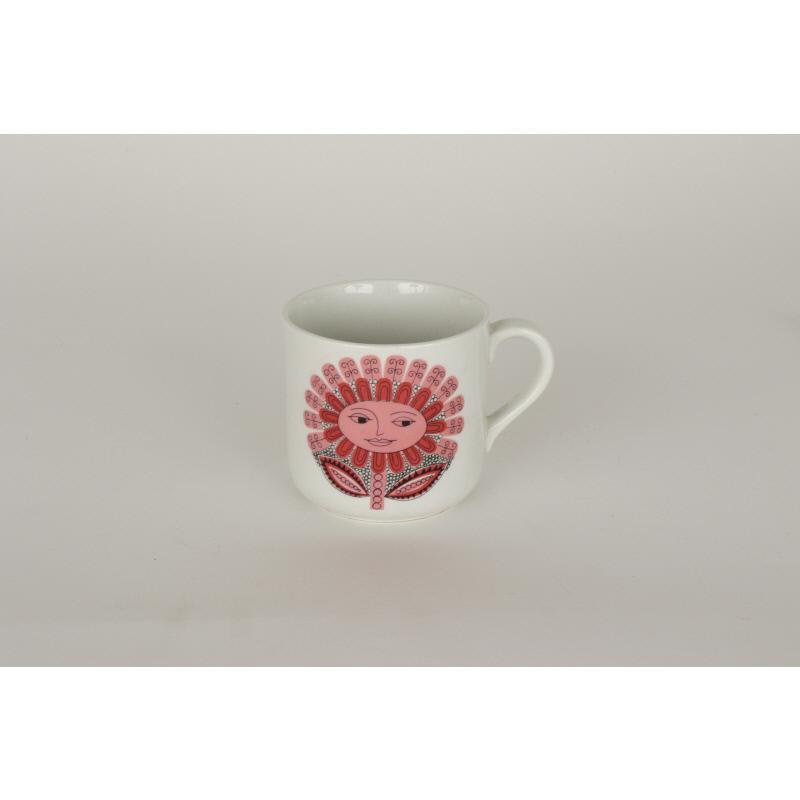Cup
Classification(s):
Pottery
Date: c. 1951-1976
Organisation: Arabia (Finland, founded 1873)
Designer: Kaj Franck (Finnish, 1911 - 1989)
Dimensions:
75 × 110 mm (7.5 × 11 cm)
Medium: Ceramic, glaze
Object number: CC070
Place of Production:Finland
DescriptionGlazed ceramic cup designed by Kaj Franck in 1967 for Arabia, made in Finland. The cup is decorated with a pink sunflower, with pink petals in concentric circles. The sunflower has a face.
The manufacturers mark is to the reverse “Arabia made in Finland 3-67”. The ILEA number is to the base.
The manufacturers mark is to the reverse “Arabia made in Finland 3-67”. The ILEA number is to the base.
ProvenanceThis object was originally acquired for the Inner London Education Authority’s (ILEA) ‘Circulating Design Scheme’ collection.
The collection was instigated by the London Country Council (later the Greater London Council) and the Council of Industrial Design (COID). The collection’s original purpose was concerned with the teaching and dissemination of modern, ‘good design’.
The collection was established in 1951/52 as the ‘Experiment in Design Appreciation’, later renamed the ‘Circulating Design Scheme’.
The Circulating Design Scheme lent boxed showcases to London schools. The showcases contained handling objects, material samples and interpretation on a specific subject.
COID withdrew its involvement in the Scheme in 1957. After which time, it was managed exclusively by the London County Council from 1957-1963.
After the administrative restructuring of London authorities, the Scheme was jointly managed by the Greater London Council and the Inner London Education Authority (ILEA) from 1963 – 1976.
The Scheme was operational until 1976 when the collections were withdrawn from circulation. ILEA was abolished in the late 1980s and the collection was donated to Camberwell College of Arts in 1989/90.
ILEA was responsible for secondary and tertiary education in the inner London boroughs, this included Camberwell.
The collection was instigated by the London Country Council (later the Greater London Council) and the Council of Industrial Design (COID). The collection’s original purpose was concerned with the teaching and dissemination of modern, ‘good design’.
The collection was established in 1951/52 as the ‘Experiment in Design Appreciation’, later renamed the ‘Circulating Design Scheme’.
The Circulating Design Scheme lent boxed showcases to London schools. The showcases contained handling objects, material samples and interpretation on a specific subject.
COID withdrew its involvement in the Scheme in 1957. After which time, it was managed exclusively by the London County Council from 1957-1963.
After the administrative restructuring of London authorities, the Scheme was jointly managed by the Greater London Council and the Inner London Education Authority (ILEA) from 1963 – 1976.
The Scheme was operational until 1976 when the collections were withdrawn from circulation. ILEA was abolished in the late 1980s and the collection was donated to Camberwell College of Arts in 1989/90.
ILEA was responsible for secondary and tertiary education in the inner London boroughs, this included Camberwell.
NotesKaj Franck, born in Finland, was a leading figure of Finnish design and applied arts in the post-war years until the 1980s. He studied furniture design at the Central School of Industrial Design in Helsinki in 1932, and began collaborating with the Arabia ceramics company in 1945 – a time when the company was seeking someone to develop more functional products, having previously been known for ornamental ceramics. The design agenda of the time had a strong social component; the aim was to produce democratic, modern objects for the home, which were both utilitarian and beautiful. Franck became Artistic Director at Arabia, but he continued to produce designs for other companies such as Iitalla (Arabia-owned Finnish glassware), where he was also Artistic Director. Franck designed porcelain objects and glassware for daily use. He earned a reputation as the conscience of Finnish design. He produced a wide range of utilitarian objects, reducing pieces to their essentials and eschewing all superfluous decoration. Franck drew inspiration from the Bauhaus School, industrial products, and traditional Japanese design.







